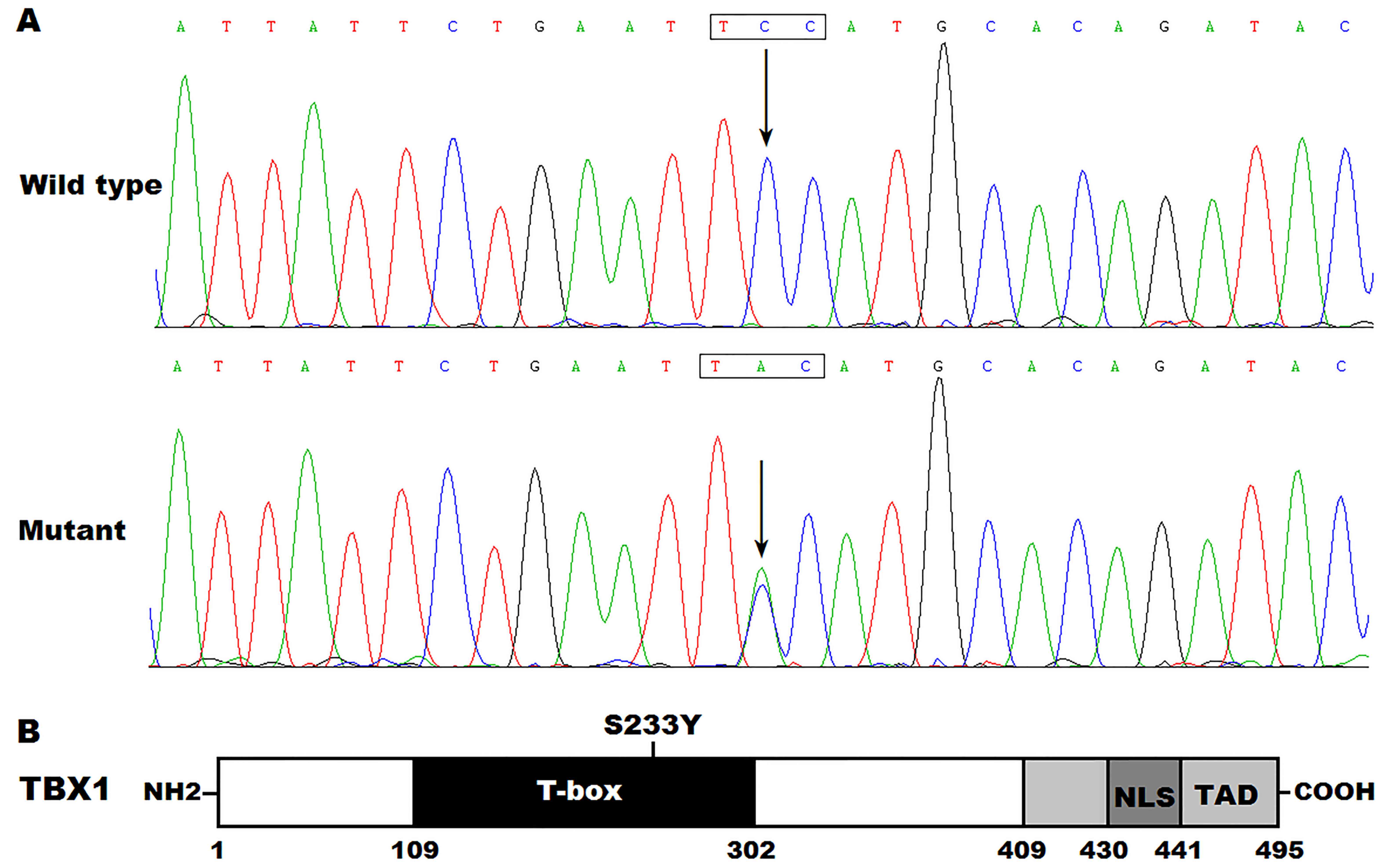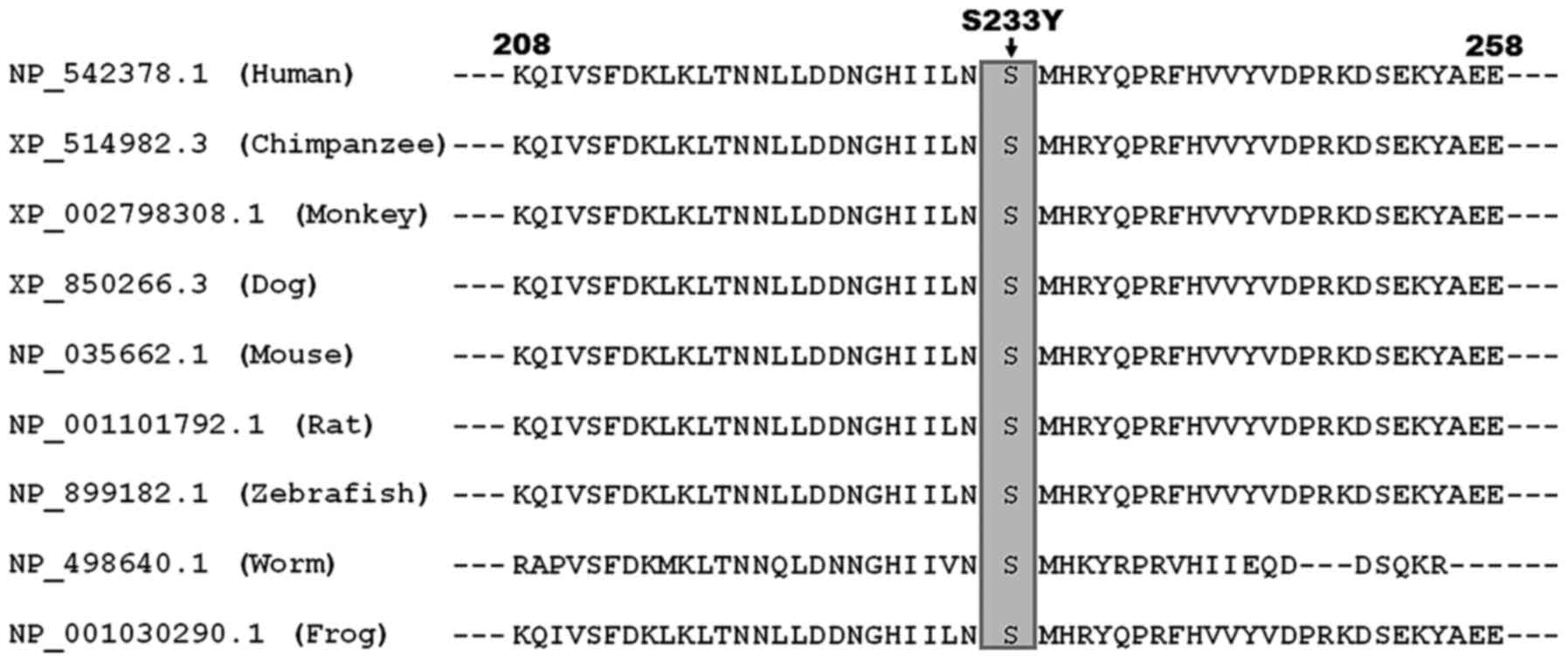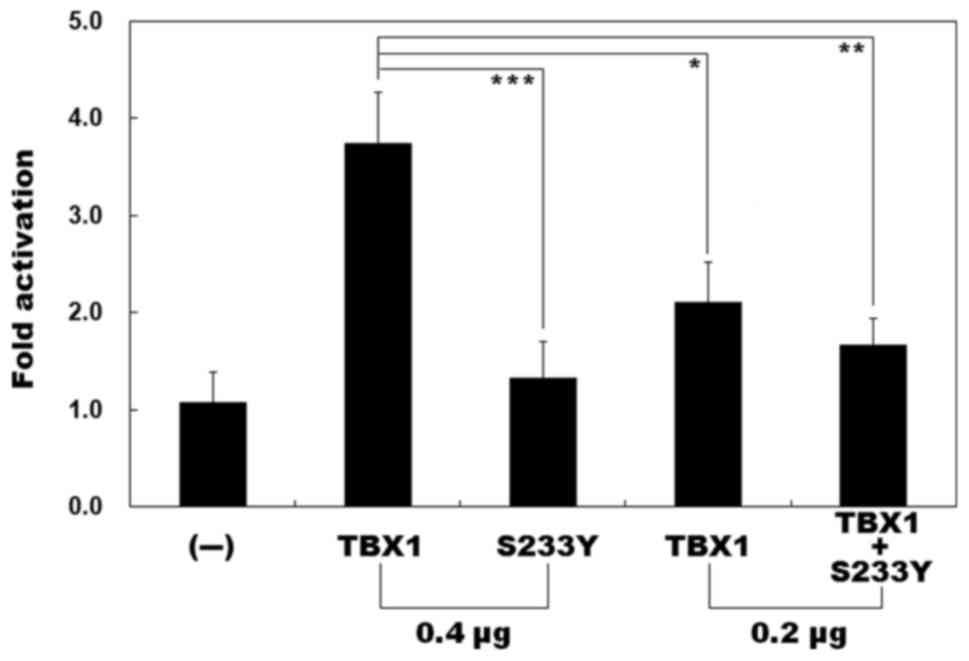|
1
|
Mozaffarian D, Benjamin EJ, Go AS, Arnett
DK, Blaha MJ, Cushman M, de Ferranti S, Després JP, Fullerton HJ,
Howard VJ, et al: Heart disease and stroke statistics-2015 update:
A report from the American heart association. Circulation.
131:e29–e32. 2015. View Article : Google Scholar : PubMed/NCBI
|
|
2
|
Agopian AJ, Mitchell LE, Glessner J,
Bhalla AD, Sewda A, Hakonarson H and Goldmuntz E: Genome-wide
association study of maternal and inherited loci for conotruncal
heart defects. PLoS One. 9:e960572014. View Article : Google Scholar : PubMed/NCBI
|
|
3
|
Zhang W, Shen L, Deng Z, Ding Y, Mo X, Xu
Z, Gao Q and Yi L: Novel missense variants of ZFPM2/FOG2 identified
in conotruncal heart defect patients do not impair interaction with
GATA4. PLoS One. 9:e1023792014. View Article : Google Scholar : PubMed/NCBI
|
|
4
|
Pan Y, Wang ZG, Liu XY, Zhao H, Zhou N,
Zheng GF, Qiu XB, Li RG, Yuan F, Shi HY, et al: A novel TBX1
loss-of-function mutation associated with congenital heart disease.
Pediatr Cardiol. 36:1400–1410. 2015. View Article : Google Scholar : PubMed/NCBI
|
|
5
|
van der Bom T, Zomer AC, Zwinderman AH,
Meijboom FJ, Bouma BJ and Mulder BJ: The changing epidemiology of
congenital heart disease. Nat Rev Cardiol. 8:50–60. 2011.
View Article : Google Scholar : PubMed/NCBI
|
|
6
|
Müller J, Engelhardt A, Fratz S, Eicken A,
Ewert P and Hager A: Improved exercise performance and quality of
life after percutaneous pulmonary valve implantation. Int J
Cardiol. 173:388–392. 2014. View Article : Google Scholar : PubMed/NCBI
|
|
7
|
Valente AM, Gauvreau K, Assenza GE,
Babu-Narayan SV, Evans SP, Gatzoulis M, Groenink M, Inuzuka R,
Kilner PJ, Koyak Z, et al: Rationale and design of an International
Multicenter Registry of patients with repaired tetralogy of Fallot
to define risk factors for late adverse outcomes: The INDICATOR
cohort. Pediatr Cardiol. 34:95–104. 2013. View Article : Google Scholar : PubMed/NCBI
|
|
8
|
Tutarel O, Kempny A, Alonso-Gonzalez R,
Jabbour R, Li W, Uebing A, Dimopoulos K, Swan L, Gatzoulis MA and
Diller GP: Congenital heart disease beyond the age of 60: Emergence
of a new population with high resource utilization, high morbidity,
and high mortality. Eur Heart J. 35:725–732. 2014. View Article : Google Scholar : PubMed/NCBI
|
|
9
|
Verheugt CL, Uiterwaal CS, van der Velde
ET, Meijboom FJ, Pieper PG, Sieswerda GT, Plokker HW, Grobbee DE
and Mulder BJ: The emerging burden of hospital admissions of adults
with congenital heart disease. Heart. 96:872–878. 2010. View Article : Google Scholar : PubMed/NCBI
|
|
10
|
Peyvandi S, Ingall E, Woyciechowski S,
Garbarini J, Mitchell LE and Goldmuntz E: Risk of congenital heart
disease in relatives of probands with conotruncal cardiac defects:
An evaluation of 1,620 families. Am J Med Genet A. 164A:1–1495.
2014.PubMed/NCBI
|
|
11
|
Racedo SE, McDonald-McGinn DM, Chung JH,
Goldmuntz E, Zackai E, Emanuel BS, Zhou B, Funke B and Morrow BE:
Mouse and human CRKL is dosage sensitive for cardiac outflow tract
formation. Am J Hum Genet. 96:235–244. 2015. View Article : Google Scholar : PubMed/NCBI
|
|
12
|
Homsy J, Zaidi S, Shen Y, Ware JS, Samocha
KE, Karczewski KJ, DePalma SR, McKean D, Wakimoto H, Gorham J, et
al: De novo mutations in congenital heart disease with
neurodevelopmental and other congenital anomalies. Science.
350:1262–1266. 2015. View Article : Google Scholar : PubMed/NCBI
|
|
13
|
Werner P, Latney B, Deardorff MA and
Goldmuntz E: MESP1 mutations in patients with congenital heart
defects. Hum Mutat. 37:308–314. 2016. View Article : Google Scholar : PubMed/NCBI
|
|
14
|
Andersen TA, Kde L Troelsen and Larsen LA:
Of mice and men: Molecular genetics of congenital heart disease.
Cell Mol Life Sci. 71:1327–1352. 2014. View Article : Google Scholar : PubMed/NCBI
|
|
15
|
Lalani SR and Belmont JW: Genetic basis of
congenital cardiovascular malformations. Eur J Med Genet.
57:402–413. 2014. View Article : Google Scholar : PubMed/NCBI
|
|
16
|
Warburton D, Ronemus M, Kline J,
Jobanputra V, Williams I, Anyane-Yeboa K, Chung W, Yu L, Wong N,
Awad D, et al: The contribution of de novo and rare inherited copy
number changes to congenital heart disease in an unselected sample
of children with conotruncal defects or hypoplastic left heart
disease. Hum Genet. 133:11–27. 2014. View Article : Google Scholar : PubMed/NCBI
|
|
17
|
Liu AP, Chow PC, Lee PP, Mok GT, Tang WF,
Lau ET, Lam ST, Chan KY, Kan AS, Chau AK, et al: Under-recognition
of 22q11.2 deletion in adult Chinese patients with conotruncal
anomalies: Implications in transitional care. Eur J Med Genet.
57:306–311. 2014. View Article : Google Scholar : PubMed/NCBI
|
|
18
|
Chen M, Yang YS, Shih JC, Lin WH, Lee DJ,
Lin YS, Chou CH, Cameron AD, Ginsberg NA, Chen CA, et al:
Microdeletions/duplications involving TBX1 gene in fetuses with
conotruncal heart defects which are negative for 22q11.2 deletion
on fluorescence in-situ hybridization. Ultrasound Obstet Gynecol.
43:396–403. 2014. View Article : Google Scholar : PubMed/NCBI
|
|
19
|
Guo T, Chung JH, Wang T, McDonald-McGinn
DM, Kates WR, Hawuła W, Coleman K, Zackai E, Emanuel BS and Morrow
BE: Histone modifier genes alter conotruncal heart phenotypes in
22q11.2 deletion syndrome. Am J Hum Genet. 97:869–877. 2015.
View Article : Google Scholar : PubMed/NCBI
|
|
20
|
Mlynarski EE, Sheridan MB, Xie M, Guo T,
Racedo SE, McDonald-McGinn DM, Gai X, Chow EW, Vorstman J, Swillen
A, et al: Copy-number variation of the glucose transporter gene
SLC2A3 and congenital heart defects in the 22q11.2 deletion
syndrome. Am J Hum Genet. 96:753–764. 2015. View Article : Google Scholar : PubMed/NCBI
|
|
21
|
Hacıhamdioğlu B, Hacıhamdioğlu D and Delil
K: 22q11 deletion syndrome: Current perspective. Appl Clin Genet.
8:123–132. 2015. View Article : Google Scholar : PubMed/NCBI
|
|
22
|
Qu XK, Qiu XB, Yuan F, Wang J, Zhao CM,
Liu XY, Zhang XL, Li RG, Xu YJ, Hou XM, et al: A novel NKX2.5
loss-of-function mutation associated with congenital bicuspid
aortic valve. Am J Cardiol. 114:1891–1895. 2014. View Article : Google Scholar : PubMed/NCBI
|
|
23
|
Zheng J, Li F, Liu J, Xu Z, Zhang H, Fu Q,
Wang J and Sun K: Investigation of somatic NKX2-5 mutations in
Chinese children with congenital heart disease. Int J Med Sci.
12:538–543. 2015. View Article : Google Scholar : PubMed/NCBI
|
|
24
|
Cao Y, Wang J, Wei C, Hou Z, Li Y, Zou H,
Meng M, Wang W and Jiang L: Genetic variations of NKX2-5 in
sporadic atrial septal defect and ventricular septal defect in
Chinese Yunnan population. Gene. 575:29–33. 2016. View Article : Google Scholar : PubMed/NCBI
|
|
25
|
Ta-Shma A, El-lahham N, Edvardson S,
Stepensky P, Nir A, Perles Z, Gavri S, Golender J,
Yaakobi-Simhayoff N, Shaag A, et al: Conotruncal malformations and
absent thymus due to a deleterious NKX2-6 mutation. J Med Genet.
51:268–270. 2014. View Article : Google Scholar : PubMed/NCBI
|
|
26
|
Zhao L, Ni SH, Liu XY, Wei D, Yuan F, Xu
L, Xin Li, Li RG, Qu XK, Xu YJ, et al: Prevalence and spectrum of
Nkx2.6 mutations in patients with congenital heart disease. Eur J
Med Genet. 57:579–586. 2014. View Article : Google Scholar : PubMed/NCBI
|
|
27
|
Wang J, Mao JH, Ding KK, Xu WJ, Liu XY,
Qiu XB, Li RG, Qu XK, Xu YJ, Huang RT, et al: A novel NKX2.6
mutation associated with congenital ventricular septal defect.
Pediatr Cardiol. 36:646–656. 2015. View Article : Google Scholar : PubMed/NCBI
|
|
28
|
Xiang R, Fan LL, Huang H, Cao BB, Li XP,
Peng DQ and Xia K: A novel mutation of GATA4 (K319E) is responsible
for familial atrial septal defect and pulmonary valve stenosis.
Gene. 534:320–323. 2014. View Article : Google Scholar : PubMed/NCBI
|
|
29
|
Han H, Chen Y, Liu G, Han Z, Zhao Z and
Tang Y: GATA4 transgenic mice as an in vivo model of congenital
heart disease. Int J Mol Med. 35:1545–1553. 2015. View Article : Google Scholar : PubMed/NCBI
|
|
30
|
Chen J, Qi B, Zhao J, Liu W, Duan R and
Zhang M: A novel mutation of GATA4 (K300T) associated with familial
atrial septal defect. Gene. 575:473–477. 2016. View Article : Google Scholar : PubMed/NCBI
|
|
31
|
Huang RT, Xue S, Xu YJ, Zhou M and Yang
YQ: Somatic GATA5 mutations in sporadic tetralogy of Fallot. Int J
Mol Med. 33:1227–1235. 2014.PubMed/NCBI
|
|
32
|
Shi LM, Tao JW, Qiu XB, Wang J, Yuan F, Xu
L, Liu H, Li RG, Xu YJ, Wang Q, et al: GATA5 loss-of-function
mutations associated with congenital bicuspid aortic valve. Int J
Mol Med. 33:1219–1226. 2014. View Article : Google Scholar : PubMed/NCBI
|
|
33
|
Huang RT, Xue S, Xu YJ and Yang YQ:
Somatic mutations in the GATA6 gene underlie sporadic tetralogy of
Fallot. Int J Mol Med. 31:51–58. 2013.PubMed/NCBI
|
|
34
|
Wang X, Ji W, Wang J, Zhao P, Guo Y, Xu R,
Chen S and Sun K: Identification of two novel GATA6 mutations in
patients with nonsyndromic conotruncal heart defects. Mol Med Rep.
10:743–748. 2014. View Article : Google Scholar : PubMed/NCBI
|
|
35
|
Wei D, Gong XH, Qiu G, Wang J and Yang YQ:
Novel PITX2c loss-of-function mutations associated with complex
congenital heart disease. Int J Mol Med. 33:1201–1208.
2014.PubMed/NCBI
|
|
36
|
Sun YM, Wang J, Qiu XB, Yuan F, Xu YJ, Li
RG, Qu XK, Huang RT, Xue S and Yang YQ: PITX2 loss-of-function
mutation contributes to tetralogy of Fallot. Gene. 577:258–264.
2016. View Article : Google Scholar : PubMed/NCBI
|
|
37
|
Lu CX, Gong HR, Liu XY, Wang J, Zhao CM,
Huang RT, Xue S and Yang YQ: A novel HAND2 loss-of-function
mutation responsible for tetralogy of Fallot. Int J Mol Med.
37:445–451. 2016. View Article : Google Scholar : PubMed/NCBI
|
|
38
|
Sun YM, Wang J, Qiu XB, Yuan F, Li RG, Xu
YJ, Qu XK, Shi HY, Hou XM, Huang RT, et al: A HAND2
loss-of-function mutation causes familial ventricular septal defect
and pulmonary stenosis. G3 (Bethesda). 6:987–992. 2016. View Article : Google Scholar : PubMed/NCBI
|
|
39
|
Baban A, Postma AV, Marini M, Trocchio G,
Santilli A, Pelegrini M, Sirleto P, Lerone M, Albanese SB, Barnett
P, et al: Identification of TBX5 mutations in a series of 94
patients with tetralogy of Fallot. Am J Med Genet A. 164A:1–3107.
2014.PubMed/NCBI
|
|
40
|
Al-Qattan MM and Al-Shaar H Abou:
Molecular basis of the clinical features of Holt-Oram syndrome
resulting from missense and extended protein mutations of the TBX5
gene as well as TBX5 intragenic duplications. Gene. 560:129–136.
2015. View Article : Google Scholar : PubMed/NCBI
|
|
41
|
Pan Y, Geng R, Zhou N, Zheng GF, Zhao H,
Wang J, Zhao CM, Qiu XB, Yang YQ and Liu XY: TBX20 loss-of-function
mutation contributes to double outlet right ventricle. Int J Mol
Med. 35:1058–1066. 2015. View Article : Google Scholar : PubMed/NCBI
|
|
42
|
Chen J, Sun F, Fu J and Zhang H:
Association of TBX20 gene polymorphism with congenital heart
disease in Han Chinese neonates. Pediatr Cardiol. 36:737–742. 2015.
View Article : Google Scholar : PubMed/NCBI
|
|
43
|
McCulley DJ and Black BL: Transcription
factor pathways and congenital heart disease. Curr Top Dev Biol.
100:253–277. 2012. View Article : Google Scholar : PubMed/NCBI
|
|
44
|
Fahed AC, Gelb BD, Seidman JG and Seidman
CE: Genetics of congenital heart disease: The glass half empty.
Circ Res. 112:707–720. 2013. View Article : Google Scholar : PubMed/NCBI
|
|
45
|
Greulich F, Rudat C and Kispert A:
Mechanisms of T-box gene function in the developing heart.
Cardiovasc Res. 91:212–222. 2011. View Article : Google Scholar : PubMed/NCBI
|
|
46
|
Gao S, Li X and Amendt BA: Understanding
the role of Tbx1 as a candidate gene for 22q11.2 deletion syndrome.
Curr Allergy Asthma Rep. 13:613–621. 2013. View Article : Google Scholar : PubMed/NCBI
|
|
47
|
Zhang Z and Baldini A: In vivo response to
high-resolution variation of Tbx1 mRNA dosage. Hum Mol Genet.
17:150–157. 2008. View Article : Google Scholar : PubMed/NCBI
|
|
48
|
Vitelli F, Huynh T and Baldini A: Gain of
function of Tbx1 affects pharyngeal and heart development in the
mouse. Genesis. 47:188–195. 2009. View Article : Google Scholar : PubMed/NCBI
|
|
49
|
Liao J, Kochilas L, Nowotschin S, Arnold
JS, Aggarwal VS, Epstein JA, Brown MC, Adams J and Morrow BE: Full
spectrum of malformations in velo-cardio-facial syndrome/DiGeorge
syndrome mouse models by altering Tbx1 dosage. Hum Mol Genet.
13:1577–1585. 2004. View Article : Google Scholar : PubMed/NCBI
|
|
50
|
Lindsay EA, Vitelli F, Su H, Morishima M,
Huynh T, Pramparo T, Jurecic V, Ogunrinu G, Sutherland HF, Scambler
PJ, et al: Tbx1 haploinsufficieny in the DiGeorge syndrome region
causes aortic arch defects in mice. Nature. 410:97–101. 2001.
View Article : Google Scholar : PubMed/NCBI
|
|
51
|
Jerome LA and Papaioannou VE: DiGeorge
syndrome phenotype in mice mutant for the T-box gene, Tbx1. Nat
Genet. 27:286–291. 2001. View
Article : Google Scholar : PubMed/NCBI
|
|
52
|
Merscher S, Funke B, Epstein JA, Heyer J,
Puech A, Lu MM, Xavier RJ, Demay MB, Russell RG, Factor S, et al:
TBX1 is responsible for cardiovascular defects in
velo-cardio-facial/DiGeorge syndrome. Cell. 104:619–629. 2001.
View Article : Google Scholar : PubMed/NCBI
|
|
53
|
Gong W, Gottlieb S, Collins J, Blescia A,
Dietz H, Goldmuntz E, McDonald-McGinn DM, Zackai EH, Emanuel BS,
Driscoll DA and Budarf ML: Mutation analysis of TBX1 in non-deleted
patients with features of DGS/VCFS or isolated cardiovascular
defects. J Med Genet. 38:E452001. View Article : Google Scholar : PubMed/NCBI
|
|
54
|
Griffin HR, Töpf A, Glen E, Zweier C,
Stuart AG, Parsons J, Peart I, Deanfield J, O'Sullivan J, Rauch A,
et al: Systematic survey of variants in TBX1 in non-syndromic
tetralogy of Fallot identifies a novel 57 base pair deletion that
reduces transcriptional activity but finds no evidence for
association with common variants. Heart. 96:1651–1655. 2010.
View Article : Google Scholar : PubMed/NCBI
|
|
55
|
Xu YJ, Chen S, Zhang J, Fang SH, Guo QQ,
Wang J, Fu QH, Li F, Xu R and Sun K: Novel TBX1 loss-of-function
mutation causes isolated conotruncal heart defects in Chinese
patients without 22q11.2 deletion. BMC Med Genet. 15:782014.
View Article : Google Scholar : PubMed/NCBI
|
|
56
|
Yagi H, Furutani Y, Hamada H, Sasaki T,
Asakawa S, Minoshima S, Ichida F, Joo K, Kimura M, Imamura S, et
al: Role of TBX1 in human del22q11.2 syndrome. Lancet.
362:1366–1373. 2003. View Article : Google Scholar : PubMed/NCBI
|
|
57
|
Paylor R, Glaser B, Mupo A, Ataliotis P,
Spencer C, Sobotka A, Sparks C, Choi CH, Oghalai J, Curran S, et
al: Tbx1 haploinsufficiency is linked to behavioral disorders in
mice and humans: Implications for 22q11 deletion syndrome. Proc
Natl Acad Sci USA. 103:pp. 7729–7734. 2006; View Article : Google Scholar : PubMed/NCBI
|
|
58
|
Torres-Juan L, Rosell J, Morla M,
Vidal-Pou C, Garcia-Algas F, de la Fuente MA, Juan M, Tuban A,
Bachiller D, Bemues M, et al: Mutations in TBX1 genocopy the
22q11.2 deletion and duplication syndromes: A new susceptibility
factor for mental retardation. Eur J Hum Genet. 15:658–663. 2007.
View Article : Google Scholar : PubMed/NCBI
|












